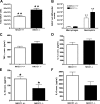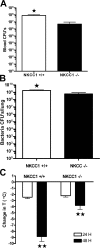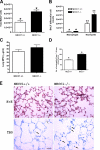Mice lacking NKCC1 are protected from development of bacteremia and hypothermic sepsis secondary to bacterial pneumonia
- PMID: 17517966
- PMCID: PMC2118609
- DOI: 10.1084/jem.20061205
Mice lacking NKCC1 are protected from development of bacteremia and hypothermic sepsis secondary to bacterial pneumonia
Abstract
The contribution of the Na(+)-K(+)-Cl(-) transporter (NKCC1) to fluid in ion transport and fluid secretion in the lung and in other secretory epithelia has been well established. Far less is known concerning the role of this cotransporter in the physiological response of the pulmonary system during acute inflammation. Here we show that mice lacking this transporter are protected against hypothermic sepsis and bacteremia developing as a result of Klebsiella pneumoniae infection in the lung. In contrast, this protection was not observed in NKCC1(-/-) mice with K. pneumoniae-induced peritonitis. Although overall recruitment of cells to the lungs was not altered, the number of cells present in the airways was increased in the NKCC1(-/-) animals. Despite this robust inflammatory response, the increase in vascular permeability observed in this acute inflammatory model was attenuated in the NKCC1(-/-) animals. Our studies suggest that NKCC1 plays a unique and untoward unrecognized role in acute inflammatory responses in the lung and that specific inhibition of this NKCC isoform could be beneficial in treatment of sepsis.
Figures










Similar articles
-
Mechanisms of neuronal chloride accumulation in intact mouse olfactory epithelium.J Physiol. 2007 Sep 15;583(Pt 3):1005-20. doi: 10.1113/jphysiol.2007.129601. Epub 2007 Jul 26. J Physiol. 2007. PMID: 17656441 Free PMC article.
-
The role of Na-K-Cl co-transporter in cerebral ischemia.Neurol Res. 2005 Apr;27(3):280-6. doi: 10.1179/016164105X25243. Neurol Res. 2005. PMID: 15845211 Review.
-
Limited role of kininogen in the host response during gram-negative pneumonia-derived sepsis.Am J Physiol Lung Cell Mol Physiol. 2018 Mar 1;314(3):L397-L405. doi: 10.1152/ajplung.00288.2017. Epub 2017 Nov 9. Am J Physiol Lung Cell Mol Physiol. 2018. PMID: 29122754 Free PMC article.
-
Klebsiella pneumoniae alleviates influenza-induced acute lung injury via limiting NK cell expansion.J Immunol. 2014 Aug 1;193(3):1133-41. doi: 10.4049/jimmunol.1303303. Epub 2014 Jun 20. J Immunol. 2014. PMID: 24951819
-
The Na-K-Cl cotransporter of secretory epithelia.Annu Rev Physiol. 2000;62:515-34. doi: 10.1146/annurev.physiol.62.1.515. Annu Rev Physiol. 2000. PMID: 10845101 Review.
Cited by
-
Surfactant Attenuates Air Embolism-Induced Lung Injury by Suppressing NKCC1 Expression and NF-κB Activation.Inflammation. 2021 Feb;44(1):57-67. doi: 10.1007/s10753-020-01266-1. Inflammation. 2021. PMID: 33089374 Free PMC article.
-
Ste20-related proline/alanine-rich kinase (SPAK) regulated transcriptionally by hyperosmolarity is involved in intestinal barrier function.PLoS One. 2009;4(4):e5049. doi: 10.1371/journal.pone.0005049. Epub 2009 Apr 3. PLoS One. 2009. PMID: 19343169 Free PMC article.
-
Combustion smoke-induced inflammation in the olfactory bulb of adult rats.J Neuroinflammation. 2014 Oct 10;11:176. doi: 10.1186/s12974-014-0176-5. J Neuroinflammation. 2014. PMID: 25297558 Free PMC article.
-
Perspective of future drugs targeting sterile 20/SPS1-related proline/alanine-rich kinase for blood pressure control.World J Cardiol. 2015 Jun 26;7(6):306-10. doi: 10.4330/wjc.v7.i6.306. World J Cardiol. 2015. PMID: 26131334 Free PMC article.
-
The roles of sodium-potassium-chloride cotransporter isoform-1 in acute lung injury.Tzu Chi Med J. 2021 Jul 5;34(2):119-124. doi: 10.4103/tcmj.tcmj_50_21. eCollection 2022 Apr-Jun. Tzu Chi Med J. 2021. PMID: 35465284 Free PMC article. Review.
References
-
- Wheeler, A.P., and G.R. Bernard. 1999. Treating patients with severe sepsis. N. Engl. J. Med. 340:207–214. - PubMed
-
- Hudson, L.D., and K.P. Steinberg. 1999. Epidemiology of acute lung injury and ARDS. Chest. 116:74S–82S. - PubMed
-
- Hasleton, P.S., and T.E. Roberts. 1999. Adult respiratory distress syndrome—an update. Histopathology. 34:285–294. - PubMed
Publication types
MeSH terms
Substances
Grants and funding
LinkOut - more resources
Full Text Sources
Medical
Molecular Biology Databases

